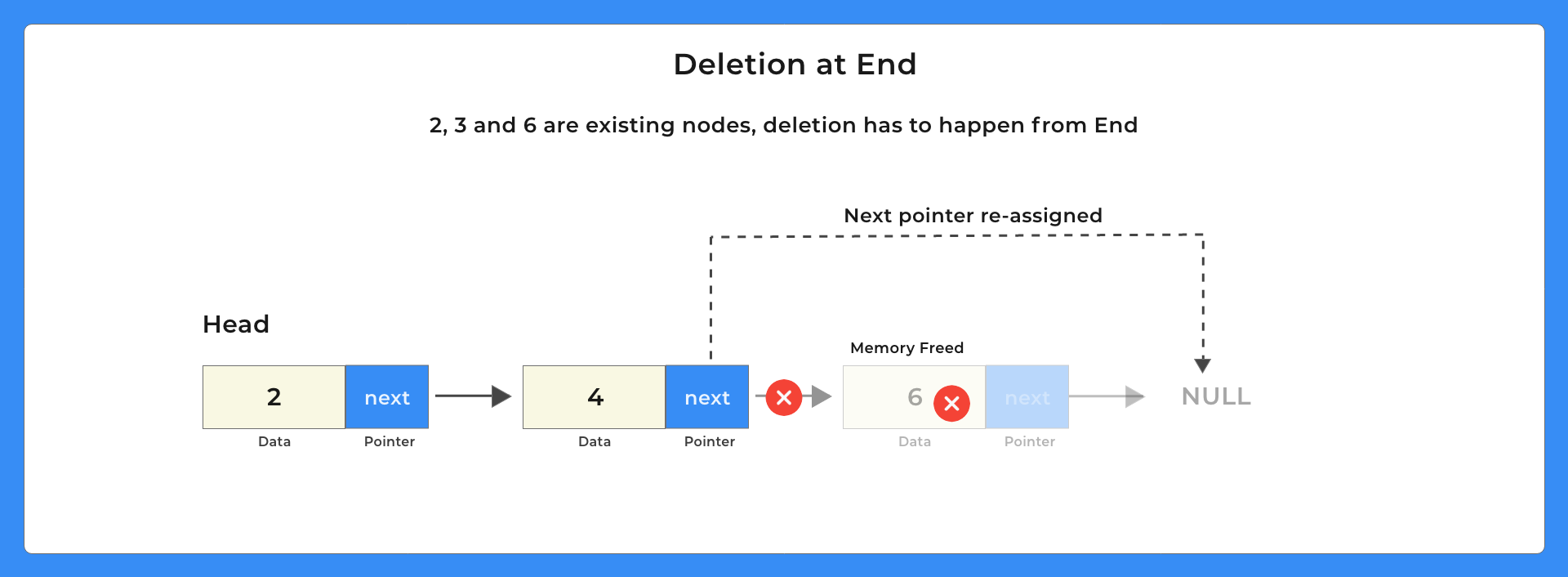C Program for Deletion at the end of the Singly Linked List
Deletion at the end of the Singly Linked List
Deletion at the end of the singly linked list program in C is mentioned below along with the method to do it and the code as well.
In other words Remove or delete the last node of the Singly Linked List in C

Steps required for deleting the node:-
- If the Linked list has only one node then make head node null
- Else traverse to the end of the linked list
- While traversing store the previous node i.e. 2nd last node
- Change the next of 2nd last node to null
- Free/delete memory of the the last node
- Now, 2nd last node becomes the last node.

Shortcode for the same –
void deleteEnd (struct Node **head)
{
struct Node *temp = *head;
struct Node *previous;
// if there are no nodes in Linked List can't delete
if (*head == NULL)
{
printf ("Linked List Empty, nothing to delete");
return;
}
// if Linked List has only 1 node
if (temp - > next == NULL)
{
printf ("%d deleted\n", (*head) - >
data);
*head = NULL;
return;
}
// else traverse to the last node
while (temp - > next != NULL)
{
// store previous link node as we need to change its next val
previous = temp;
temp = temp - >
next;
}
// Curr assign 2nd last node's next to Null
previous - >
next = NULL;
// delete the last node
printf ("%d deleted\n", temp - >
data);
free (temp);
// 2nd last now becomes the last node
}
C Code for deletion at the end of the Singly Linked List:-
Let us look at the code below for the same –
Run
#include<stdio.h>
#include<stdlib.h>
struct Node
{
int data;
struct Node *next;
};
void deleteEnd (struct Node **head)
{
struct Node *temp = *head;
struct Node *previous;
// if there are no nodes in Linked List can't delete
if (*head == NULL)
{
printf ("Linked List Empty, nothing to delete");
return;
}
// if Linked List has only 1 node
if (temp->next == NULL)
{
printf ("%d deleted\n", (*head)->data);
*head = NULL;
return;
}
// else traverse to the last node
while (temp->next != NULL)
{
// store previous link node as we need to change its next val
previous = temp;
temp = temp->next;
}
// Curr assign 2nd last node's next to Null
previous->next = NULL;
// delete the last node
printf ("%d deleted\n", temp->data);
free (temp);
// 2nd last now becomes the last node
}
void display (struct Node *node)
{
// as linked list will end when Node is Null
while (node != NULL)
{
printf ("%d ", node->data);
node = node->next;
}
printf ("\n\n");
}
int main ()
{
//creating 4 pointers of type struct Node
//So these can point to address of struct type variable
struct Node *head = NULL;
struct Node *node2 = NULL;
struct Node *node3 = NULL;
struct Node *node4 = NULL;
struct Node *node5 = NULL;
struct Node *node6 = NULL;
// allocate 3 nodes in the heap
head = (struct Node *) malloc (sizeof (struct Node));
node2 = (struct Node *) malloc (sizeof (struct Node));
node3 = (struct Node *) malloc (sizeof (struct Node));
node4 = (struct Node *) malloc (sizeof (struct Node));
node5 = (struct Node *) malloc (sizeof (struct Node));
node6 = (struct Node *) malloc (sizeof (struct Node));
head->data = 2; // data set for head node
head->next = node2; // next pointer assigned to address of node2
node2->data = 4;
node2->next = node3;
node3->data = 6;
node3->next = node4;
node4->data = 8;
node4->next = node5;
node5->data = 10;
node5->next = node6;
node6->data = 12;
node6->next = NULL;
printf ("Linked list: ");
display (head);
deleteEnd (&head);
deleteEnd (&head);
printf ("\nLinked list: ");
display (head);
return 0;
}
Output
Linked list: 2 4 6 8 10 12
12 deleted
10 deleted
Linked list: 2 4 6 8
Operation performed for Deletion in Singly Linked List as following:-
- Deletion at the beginning of the Singly Linked List
- Deletion at the end node of the Singly Linked List
- Deletion at the nth node of the Singly Linked



Login/Signup to comment